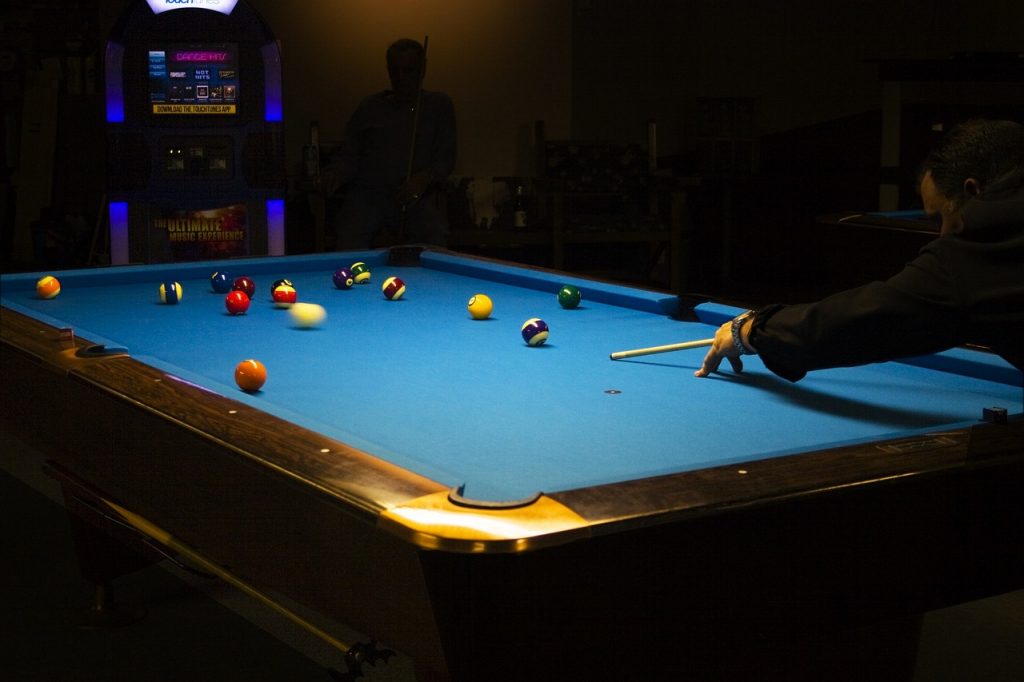
Ah, the long, straight shot in pocket billiards. A seemingly simple feat, yet one that can send even seasoned players into a cold sweat. It’s a test of focus, precision, and that elusive quality known as “cue straightness.” Mastering this fundamental skill unlocks a new level of control and confidence on the felt, leaving your opponents wondering if you’ve suddenly sprouted a laser sight for an eye. Let’s tackle how to hit the long shots.
But fear not, sharks in training! This article is your ultimate guide to conquering the long and straight. We’ll delve into the secrets of a smooth stroke, tackle common mistakes, and equip you with drills and practice strategies to hone your cue into a straight-shooting samurai.
Gearing Up for Greatness: Tools of the Trade
Before we dive into the nitty-gritty, let’s ensure you’re armed with the right equipment:
- A quality cue: Invest in a cue that feels comfortable and balanced in your hands. The weight, length, and tip material all play a role in stroke consistency.
- Good chalk: Fresh chalk helps prevent miscues and ensures optimal grip on the cue ball.
- A level playing field: A warped table can throw off your aim and make straight shots a nightmare.
The Foundation of Finesse: The Perfect Stroke
Now, let’s talk turkey – the stroke itself. A smooth, controlled stroke is the bedrock of cue straightness. Here’s the breakdown:
Grip: Use a relaxed, firm grip that allows for natural follow-through. Avoid death grips that tighten up your stroke and introduce unwanted wobbles.
Stance: Stand with your feet shoulder-width apart for stability and balance. Keep your body aligned with the shot line.
Backswing: Start with a short, controlled backswing, keeping your elbow close to your body. Avoid jerky movements that can transfer unwanted English onto the cue ball.
Forward Stroke: Accelerate smoothly through the cue ball, maintaining a consistent stroke speed. Imagine your arm acting like a piston, transferring energy directly to the cue ball.
Follow-through: Extend your arm naturally after contact, allowing the cue to follow through the shot. This helps prevent miscues and ensures proper cue ball control.
Mind Your Ps and Qs: Common Mistakes to Avoid
Even the best players fall prey to occasional blunders. Here are some common mistakes to keep an eye out for:
- Jerky stroke: This can impart unintentional English on the cue ball, sending it careening off course. Focus on a smooth, controlled motion.
- Dipping the cue: Lowering the cue tip after contact can cause the cue ball to jump or swerve. Maintain a level cue throughout the stroke.
- Following through too early: Lifting your head or cue too soon can disrupt your shot. Let your arm naturally extend after contact.
- Aiming with your eyes: While your eyes play a role in lining up the shot, focus on feeling the cue’s path through your arm and hand. This develops muscle memory for a straighter stroke.
Practice Makes Perfect: Drills to Hone Your Skills
The path to cue straightness is paved with practice. Here are some drills to refine your stroke and conquer those long shots:
- Ghost strokes: Practice your stroke without hitting the cue ball, focusing on smooth follow-through and a consistent feel.
- Short-distance straights: Start with lining up the cue ball and object ball close together, gradually increasing the distance as your accuracy improves.
- Rail lines: Use the table rails as visual aids to ensure your stroke is traveling straight. Practice hitting cue balls against the rail and back to your tip.
- Stop shots: Learn to control the cue ball’s travel distance by practicing stopping it directly behind the object ball after contact.
More info on cueing straight: https://billiardsguru.com/how-to-cue-straight-in-pool/
Get the right equipment (I am buying a cue from here): https://www.pooldawg.com/
Bonus Tip: The Zen of Focus
Maintaining focus and composure is crucial for long, straight shots. Take a deep breath before each shot, clear your mind, and visualize the cue ball smoothly gliding into the pocket. Trust your practice and let muscle memory guide your stroke.
Remember: Mastering cue straightness is a journey, not a destination. Be patient, celebrate your progress, and most importantly, have fun! With dedication and the right approach, you’ll be sinking those long, straight shots like a seasoned pro in no time.
Discover more from Billiards and Pool
Subscribe to get the latest posts sent to your email.